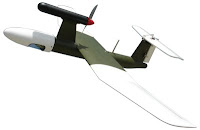

Being certified for 'Secret' classification and at just 25 cubic inches (410 cm 3) (measuring 3 in × 5.3 in × 1.6 in) and weighing 18 oz (510 g), the Harris SSDL allows the small Raven UAS to extend communications for troops in the field. Acting as communications nodes for ground forces has become an important function for UASs, but has been restricted to larger platforms like the RQ-4 Global Hawk or RQ-21 Blackjack. In mid-2015, the US Marine Corps tested Harris Corporation's Small Secure Data Link (SSDL), a radio device that fits onto a Raven's nose to provide beyond line-of-sight communications for Marines down to squad level. The UAS can provide day or night aerial intelligence, surveillance, target acquisition, and reconnaissance. The Raven lands itself by auto-piloting to a pre-defined landing point and then performing a 45° slope (1 foot down for every 1 foot forward) controlled "Autoland" descent.
AMERICAN UAV DRONE FREE
The RQ-11B Raven UA is launched by hand, thrown into the air like a free flight model airplane. The RQ-11B Raven UA weighs about 1.9 kg (4.2 lb), has a flight endurance of 60–90 minutes and an effective operational radius of approximately 10 km (6.2 miles). Standard mission payloads include CCD color video cameras and an infrared night vision camera. The UA can be ordered to immediately return to its launch point by pressing a single command button. The Raven can be either remotely controlled from the ground station or fly completely autonomous missions using GPS waypoint navigation. A new Digital Data Link-enabled version of Raven now in production for US Forces and allies has improved endurance, among many other improvements. More than 19,000 Raven airframes have been delivered to customers worldwide to date. It has also been adopted by the military forces of many other countries (see below). Shortly afterwards, it was also adopted by the US Marines, and the US Air Force for their ongoing FPASS Program.

It was the winner of the US Army's SUAV program in 2005, and went into Full-Rate Production (FRP) in 2006. The Raven RQ-11B UAS is manufactured by AeroVironment. The plane can fly up to 10 km at altitudes of approximately 150 m above ground level, and over 4,500 m above mean sea level, at flying speeds of 45–100 km/h. The craft is launched by hand and powered by a pusher configuration electric motor. The RQ-11 Raven was originally introduced as the FQM-151 in 1999, but in 2002 developed into its current form, resembling an enlarged FAI class F1C free flight model aircraft in general appearance. The AeroVironment RQ-11 Raven is a small hand-launched remote-controlled unmanned aerial vehicle (or SUAV) developed for the United States military, but now adopted by the military forces of many other countries.


 0 kommentar(er)
0 kommentar(er)
